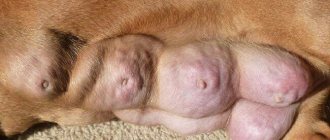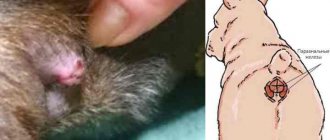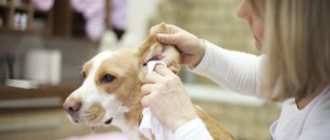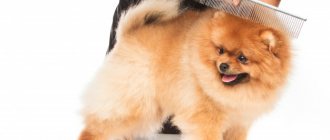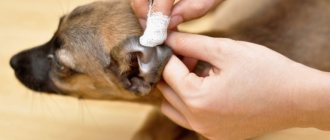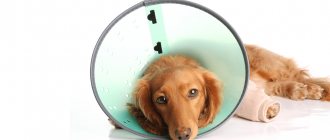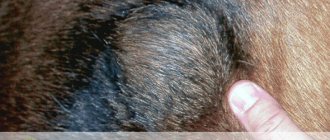What are the anal glands for in dogs?
By the way, what kind of organs are these and what are the paraanal glands for in dogs? Let's answer the first question first. The paraanal glands, also called “peri-anal sinuses,” are two small organs located on the sides of the animal’s anus.
The sinuses secrete a brownish secretion that has an extremely unpleasant, “stunning” odor. In addition, it is quite aggressive from a chemical point of view. These secretions are necessary to lubricate feces at the final stage of their movement into the external environment.
They prevent the development of constipation and irritation of the anus. In addition, the “fragrant” secretion is necessary for the identification of an animal by its relatives by smell; dogs use it to mark out their territory.
The odorous secretion of these glands is essential for normal life. The problem is that secretion in the sinuses is poorly regulated by the body. Normally, the secretion is enough to moisten your pet's feces up to three times a day (this is the normal frequency of bowel movements for an adult dog).
Symptoms of the disease
If a dog has inflammation of the paraanal glands, the symptoms of the disease will depend on the extent of their damage. Initially, when the pathology just begins to develop, it is quite difficult for an inexperienced person to detect violations, since the animal’s behavior practically does not change. As the disease progresses, the secretory fluid begins to thicken and become darker in color. At this stage of the disease, the dog begins to behave differently. If you look closely, you can notice stiffness of movement in the lower limbs. Alopecia gradually develops, and pustules and vesicles appear on the skin.
Lack of treatment leads to the fact that the secretion becomes a creamy consistency.
The amount of discharge is significantly reduced, and the color of the liquid becomes even darker. Due to the intensification of the neurological syndrome, the itching in the pathological area becomes even more intense. When the secretion becomes thick or grainy, it turns dark brown or black. At this stage, the course of the disease leads to paralysis of the pelvic girdle or half of the animal’s body.
Signs of inflammation of the paraanal gland may be as follows:
- increased irritability;
- lack of appetite;
- scratching and licking the skin at the base of the tail;
- painful touch to the affected area;
- swelling of the anal area;
- anal spasms;
- rectal-cutaneous fistulas are formed;
- hypertrophic compaction of the epidermis;
- The coat and skin become damp.
The likelihood of a secondary infection entering is quite high, since the animal is constantly trying to scratch the affected area in every possible way.
An abscess of the paraanal gland in a dog is characterized by the appearance of an open ulcer through which yellow liquid constantly flows. The inflammatory process gradually spreads to neighboring tissues.
Reasons for the development of inflammation
Here are the main reasons for the development of inflammation:
- Chronic constipation. If the dog does not poop, then the secretion of the paraanal sinuses is not released. And we already wrote above that it is secreted constantly. Because of this, the glands quickly become overcrowded, they become inflated, and the aggressive secretion begins to corrode the tissue of the sinuses themselves.
- Genetic predisposition. Zoologists have clearly established that wolves, for example, practically do not suffer from blocked sinuses, while for dogs this pathology is a real “calling card”. Most likely, this is due to the altered digestive tract of dogs (a consequence of long-term selection). In addition, small breeds get sick more often. But the latter is most likely due to the improper nutrition of such animals. Their owners too often spoil their dogs with handouts from their table.
- Poor quality food. It is known that dogs whose owners feed their pets high-quality canned food or well-selected “natural” food rarely suffer from inflammation of the paraanal sinuses. If the dog is constantly “stuffed” with dry food of dubious origin, or the dog eats food from the human table (completely not healthy for him), the likelihood of developing the disease is much higher.
- Worm diseases. In many species of parasitic nematodes, the female crawls out of the animal's anus and lays eggs on the skin around the anus. Because of this, severe itching develops; the dog constantly scratches and licks the anal area. All this leads to inflammation of the sinuses.
- Gastrointestinal diseases. With severe diarrhea, the area around the anus becomes very irritated and inflamed. These are ideal conditions for inflammation of the perianal glands.
- Feeding bones (especially chicken bones). Since this “delicacy”, when eaten by a dog, splits into thin, sharp fragments, these pieces seriously injure and injure the entire digestive tract (there are even cases of peritonitis). Accordingly, the risk of damage to the sinuses is also quite high.
- Systemic infectious diseases. The causative agent of infection (especially a virus) can enter any organ and tissue of the body. The perianal glands are no exception.
Why do they appear?
Comedones are always black in color because fat oxidizes when exposed to oxygen. They are harmless. But they can become a sign of a bacterial infection, ringworm or hormonal diseases in the dog.
Important! Some cases of acne in dogs are caused by trauma to the skin of the chin. As a result, hair follicles become inflamed and acne spreads to other areas of the skin.
In adult animals they occur for the following reasons:
- food allergies from dry dog food;
- poor hygiene;
- bacterial infection;
- fungal infections;
- hormonal pathologies;
- dermatitis due to skin parasites;
- chin injuries.
Factors promoting development
Just like human acne, dog acne does not appear one at a time, but a lot at once. Most owners say that the “pimples” appear suddenly. Indeed, there is no one general reason for the appearance of comedones in a dog. But there are several that are considered the most significant.
Some reasons will vary depending on age. For example, this is quite normal for puppies. Their teenage acne season occurs between 5 and 8 months. In some dogs, comedones appear even at the age of two.
Which dogs are predisposed to the disease?
Another important reason is genetic predisposition. Acne is common in pets with short hair.
But most often they are present in representatives of the following breeds:
- boxers;
- English bulldogs;
- Great Danes;
- German shorthaired pointers;
- Weimaraners;
- mastiffs;
- Rottweilers;
- Doberman pinschers.
Did you know? Allergies aggravate the formation of comedones.
This does not mean that other breeds cannot have comedones. It’s just that in those listed above they are diagnosed much more often.
Symptoms of inflammation of the paraanal glands
Veterinarians and experienced breeders identify the following, the most typical symptoms of inflammation of the paraanal glands:
- Often sick dogs begin to “roll” on their butts on the floor. Some animals scratch their anus intensively on corners, furnishings, and even bushes. Many breeders believe that this is how helminthic diseases manifest themselves (which is partly true), they stuff the pet with anthelmintics and only worsen the dog’s condition.
- Swelling and redness of the anus itself is noticeable. In addition, the anus is itchy. The dog, as already described above, either “rides” along the floor or constantly licks the “loin part”.
- When defecating, the dog experiences visible discomfort, howls and whines. Often, owners think that their pet is constipated, they give him a “killer” dose of laxatives... after which the dog gets even worse.
- In advanced cases, the anal area becomes completely bald, the skin in these places becomes red, rough, and inflamed. Because of this, the animal constantly licks and even gnaws the area that worries it, which only worsens its general condition. In these cases, additional microflora gets into the wounds and combs, which leads to very serious consequences.
- The natural outcome of advanced cases of inflammation of the paraanal glands is the formation of an abscess. In the best case, the abscess opens after some time and its contents flow out. From the outside, it looks like a small hole through which thick, yellowish-green or brownish pus with a very unpleasant odor leaks. As a rule, the dog becomes apathetic, lethargic and inactive, and the overall body temperature rises (in short, standard signs of purulent inflammation). But all these are “flowers”. There are cases when the abscess does not open outward, but inward. The result is fulminant purulent peritonitis with a chance of survival of no more than 30%.
What are paraanal glands?
Many dog owners don’t even suspect that their pets have these same paraanal glands (they are also called bags) and this is good, but until then, their household members do not have problems with these glands...
The bags are located inside the anus, before the exit from it. Both urine and feces of a dog have a specific smell, which acts as a “calling card” of the animal. The anal glands mix with feces during defecation and give the dog's waste products a smell that is unique to him.
During normal functioning of the animal’s gastrointestinal tract, these glands independently release secretions into the feces. It’s not for nothing that they are called “bags”, because, in fact, they are bags that contain a specific secret.
During the act of defecation, with normal, formed stool in an animal, feces squeeze out secretions from the bags. That is, while your dog walks around, its bags are freed from secretions.
It happens that a dog never has problems with the bags, but, unfortunately, it happens that these bags become clogged and the pet experiences severe discomfort, while its health is in danger.
Why do problems with the glands occur?
You must understand that problems with bags can only arise in cases where too much secretion accumulates in the anal glands and it does not come out for a long time. This problem usually occurs because the dog:
- leads a sedentary lifestyle, which leads to weak intestinal motility (this affects the appearance of problems with the formation and excretion of feces, as a result, the secretion is not removed from the bags);
- does not eat properly, which can lead to constipation or diarrhea (in both the first and second cases, feces will not be able to help remove secretions from the bags);
- often suffers and cannot go out for a long time (for example, this can happen if you have taught her to perform the act of defecation only on the street, but forget to walk her).
As you understand, problems with the anal glands are a direct consequence of the fact that the dog has problems with excreting feces or weak intestinal motility.
When should you clean?
Dogs, despite the fact that they do not have such strong intelligence as humans, are quite smart animals and try to take care of their health on their own.
If problems arise with their bags, she tries to squeeze them out herself. At such moments, their behavior becomes strange, but they do exactly what their instincts tell them.
If there are problems with the bags, the dog:
- begins to fidget with its rear end on the floor with a fleecy surface (in this case, inexperienced dog breeders believe that the dog has worms, but they could be very mistaken!);
- if the dog fails to squeeze out the secretion in the manner described above, it begins to gnaw under its tail and suddenly turns towards its anus.
If you notice this behavior in your household, then you need to help him cleanse the paraanal glands from the secretions that have accumulated in them.
If you are a squeamish person or are afraid that you might make mistakes when cleaning your pet’s bags, then contact your veterinarian. In fact, this procedure is very easy and, after carefully reading the algorithm for its implementation, which is described below, you can clean your dog’s bags yourself.
How to clean it properly?
Before you begin the procedure of cleaning the secretion bags, you need to make sure that your pet has a problem with the paraanal glands and the secretion that has accumulated in them.
To do this, you need to palpate the dog's anus from the inside, closer to the exit from the rectum. Perform this procedure with gloves, for known reasons.
Apply little or no force to the glands with your index finger, so as not to cause discomfort to your dog. A slight pressure on the bag is enough to understand that it is clogged. This conclusion can be drawn if it is dense. With normal secretion, the bags are soft and practically not palpable (cannot be felt).
If you find seals, then feel free to proceed with the procedure of cleaning the bags. Below are two methods that can easily be used at home to clean secretion bags.
Method one:
- You need to prepare gloves and ask a person for help (he will have to hold the dog's muzzle and support it under his belly).
- The dog must be placed in the bath (if you have a small breed, you can use an ordinary basin).
- Put gloves on both hands and feel for the bags.
- In order for the dog's sphincter to relax, you need to lift its tail up - do this before your pet begins to feel pain. That is, you hold the dog by the tail with one hand, and with the other you will squeeze out the secretion from the paraanal glands.
- Gently squeeze out the secretion by squeezing the area that is located on the sides of the anus. If you did everything correctly, a foul-smelling liquid with a viscous consistency will come out of the bags.
Attention! You should not use brute physical force in this matter and put too much pressure on the bags.
If after several attempts at squeezing you do not see any result in the form of secretion coming out, then stop squeezing.
In this case, you need to contact a specialist, because your dog’s bags are very clogged, and this can lead to a number of serious consequences (they will be revealed after describing the second method of clearing the paraanal glands from secretions).
Method two:
The main difference between the second method and the first is that you have to penetrate the anus. That is, in addition to gloves and an assistant, you need to prepare Vaseline (you will lubricate your index finger with it to penetrate your dog’s anus).
Algorithm of the second method:
- with our left hand we lift the dog’s tail;
- with the index finger of your right hand, which you have previously lubricated with Vaseline, enter the anus;
- with the thumb of the right hand (outside the anus) and the index finger (inside the anus) we squeeze the sac clogged with secretions;
- as a result, the secretion comes out.
As you can see, there is nothing difficult. Please note that the role of the assistant in the first and second methods is very important (especially in the second).
You must prepare him for the fact that the dog may start to break out. Therefore, he must be gentle, but at the same time not allow the dog to escape.
To do this, the assistant holds the dog under the lower jaw with one hand, and with the other under the pet’s belly.
Unpleasant consequences of clogged glands
There are three main consequences of clogged paraanal glands:
- Dog discomfort during defecation.
- Inflammation. It is a consequence of the onset of decay in the anal glands. It is characterized by redness of the bags, pain on palpation and anxiety of the dog. If the dog owner does not pay attention to the appearance of inflammation in the area of the paraanal glands, a terrible consequence may occur - an abscess.
- Abscess. It occurs if the owner does not pay attention to the inflammatory process in the anal area. It can be compared to a bursting balloon. That is, the secretion accumulates in the anal glands for a long time and has no outlet. Then, the wall of the bag bursts and the contents come out.
Treatment regimen at home
The following treatment regimen at home is quite approximate; it must be adjusted based on the characteristics of a particular case of illness. In most cases, treatment is carried out as follows:
- The fur around the anus is carefully trimmed.
- Pus, dried pieces of excrement and other contaminants are washed off using either a sterile saline solution or a chlorhexidine solution. This is not a very pleasant job, but it will greatly facilitate subsequent procedures and prevent further development of the inflammatory process. Cleaning is repeated daily.
- To destroy pathogenic microflora, antibiotics or other antimicrobial agents are used in the form of injections, tablets, and rectal suppositories.
- Anti-inflammatory corticosteroids are usually prescribed.
- If necessary, antifungal agents are prescribed.
- To make the process of defecation easier for the pet, I use sedatives and painkillers.
- If the inflammation cannot be controlled, the affected glands must be removed surgically.
Drugs used
We will describe the main drugs used that help quickly (relatively) and with little cost to cope with inflammation of the paraanal sinuses.
Ointments
For inflammation of the sinuses, veterinarians use the following ointments:
- Tetracycline ointment 3% (1% does not need to be used, it is used only in ophthalmology).
- Vishnevsky's balsamic liniment. An odorous, but extremely effective remedy that allows you to quickly stop the inflammatory process and speed up healing.
- Synthomycin liniment.
- Zinc ointment. Significantly accelerates regeneration processes.
- Ichthyol ointment has the same effect. In addition, it perfectly disinfects and relieves inflammation.
Antibiotics
Since inflammation of the perianal sinuses is a quite serious and dangerous disease, antibiotics are prescribed without fail. Dogs are allowed to administer the following medications:
- All drugs from the group of cephalosporins. They are effective and quite safe for the animal’s body.
- In severe cases, drugs from the tetracycline group can be used, but this must be done with caution, as they are very toxic and can severely damage the animal’s liver and kidneys.
Rectal suppositories
The following rectal suppositories (suppositories) can be used to relieve inflammation, pain and itching:
- Ichthyols.
- Suppositories with furatsilin.
- Suppositories with ichthyol/furatsilin and novocaine.
- Pure novocaine suppositories.
During the administration of suppositories, the dog must be placed on its side. It is advisable to keep your pet in this position for at least five minutes. In this case, the candle will go deep enough into the rectum and subsequently will not fall out.
Inflammation and cleaning of anal sacs
Cleaning the paraanal (anal) glands in dogs is a necessary, although unpleasant hygienic procedure for many breeders.
Not everyone knows that blockage of the anal glands can provoke inflammation, cause anxiety for a pet, lead to a deterioration in the condition of the coat, and the development of various other complications.
That is why dog breeders should know how to properly clean the anal sacs from excess secretions.
When should you clean?
Anal (paraanal) glands are a paired secretory organ that produces a thick secretion that has a specific, rather unpleasant odor, which dogs use to mark their territory, attract the attention of individuals of the opposite sex, and scare away enemies. Located next to the anus, they look like small pear-shaped sacs. The ducts of the secretory organ open into the lumen of the rectum.
As a rule, cleaning of the paraanal glands in dogs, cats, and other animals occurs during the act of defecation. But if the secretory organs are overfilled, the glands increase in size and become inflamed. The secretion thickens and acquires an unpleasant, foul odor, which indicates the development of acute inflammation.
Dogs experience discomfort, pain when walking, during the act of emptying (defecation).
They begin to gnaw the base of the tail, lick the anus, run in circles, “ride” on the butt in order to squeeze out the accumulated secretion. Secretion substances are absorbed into the blood, which leads to allergic reactions, severe itching, and intoxication.
The skin around the anus is very hyperemic and irritated. Scratching, wounds, and sores are noticeable. The fur near the anus becomes dull and falls out.
The inflammatory process can spread to nearby tissues. An abscess forms, which breaks through the skin, leading to the formation of a temporary fistula. When the paraanal glands become inflamed, a sharp increase in temperature is noted. The dog is very thirsty and may refuse food or treats offered. In this case, you should immediately clean the anal glands.
Why do they become inflamed?
The reasons that led to blockage of the anal glands in dogs are very different. So, this pathology can be provoked by:
- poor quality, unbalanced diet;
- sedentary lifestyle;
- feeding the dog low-quality dry food;
- autoimmune diseases;
- lack of necessary hygiene procedures;
- weakening of immunity and resistance.
Often the cause of blockage of secretory organs lies in the breed, genetic predisposition. Most often, blockage of the paraanal glands is observed in high-breed dogs, representatives of decorative, miniature breeds.
How to clean it yourself
If the glands are clogged, it is necessary to clean them mechanically. This procedure can be entrusted to a veterinarian or carried out independently, with the support of an assistant who will hold the dog during the hygiene procedure.
Before cleaning, you should prepare Vaseline, sterile rubber gloves, disposable wipes or diapers. Holding the pet's tail at the base, the index finger is carefully inserted into the rectum. Small pear-shaped bags are felt on both sides of the anus.
With your other hand (either a gloved hand or a tissue), gently apply pressure to the area on the sides of the anus. Gradually increasing the force with circular massaging movements, you should try to squeeze the secretion out of the cavity of the glands. Carry out all manipulations as carefully as possible so as not to cause pain to your beloved dog.
After cleaning, it is recommended to insert anti-inflammatory rectal suppositories into the rectum, which can be purchased at a veterinary pharmacy or veterinary clinic.
In case of severe blockage of the anal glands, veterinary specialists put novocoin blockades with antibiotics on the dogs, and wash the sinuses with antiseptic saline solutions. The course of treatment takes approximately 10-15 days.
In case of abscess formation of the affected areas, the hair is shaved and symptomatic therapy is prescribed, which is aimed at removing purulent contents and normalizing the general condition. Chronic fistula cannot be treated without surgical treatment. In dogs, inflamed paraanal glands are completely removed. The operation is performed in a veterinary hospital under general anesthesia.
Source: https://localvet.ru/sobaki/uhod/paraanalnye-zhelezy
In what cases is it necessary to contact a veterinarian?
Sometimes a sick dog needs to be urgently taken to the clinic, as delay can be fatal. Here are the cases in which you will need to contact a veterinarian:
- The dog does not eat, does not drink, constantly lies in one position, avoiding moving.
- The dog's abdomen in the rear quarter is very tense and so painful that the pet does not even allow him to be touched. The surest sign of peritonitis!
- The animal's general body temperature rose sharply.
- The dog whines, howls, and licks the genital area all the time.
Surgical methods of treatment
Note that modern veterinary medicine prefers surgical methods for treating inflammation of the paraanal sinuses.
This is due to disappointing statistics: if a dog’s glands become inflamed or clogged at least once, then there will definitely be relapses. The probability of recurrence is almost 100%.
Therefore, they resort to the following methods:
- The most common option is surgical sinus resection. The operation is called saculectomy. The procedure is extremely simple: two incisions are made (under local anesthesia), the “bags” are brought out, excised, the stump is bandaged with catgut and lubricated with an alcohol tincture of iodine.
- In some cases, cryogenic surgery is resorted to. In this case, the glands are “frozen out” with liquid nitrogen, after which they naturally atrophy and become overgrown with connective tissue. The technique has not gained much popularity due to its considerable cost.
Treatment of inflammation in puppies
In general, the treatment of inflammation in puppies is not much different from the treatment of adult dogs, but there are certain nuances:
- Strong antibiotics are not used unless absolutely necessary.
- Mechanical cleaning of sinuses in small puppies is risky, because... The gland tissues are too delicate and thin.
- When using rectal suppositories to treat a puppy, the suppository must be cut lengthwise into four parts, and these “straws” must be inserted into the rectal opening. If you stuff the whole suppository there, you can aggravate and aggravate the course of the disease.
- Since puppies have a slightly higher pain threshold, and the rate of regeneration is much higher than in adult dogs, veterinarians recommend immediately resorting to surgical excision of the glands. If the sinuses begin to bother the animal at this age, then everything will only get worse. There is no need to torture your pet: the pararectal glands are not vital organs!
Consequences and possible complications
As we mentioned above, the consequences and possible complications are quite serious:
- The worst thing is the possibility of internal abscesses forming and opening into the abdominal cavity. The result is purulent peritonitis with almost 100% mortality (even people with such pathology are rarely saved).
- Constant relapses (and they will happen) lead to the development of severe constipation. And the latter are the key to disgusting digestion, poor absorption of nutrients, autointoxication, etc.
- Due to chronic itching and pain, the pet becomes nervous, irritable, eats poorly, and develops exhaustion.
- In advanced cases, sepsis is possible.
Diet and feeding of a dog with inflammation of the paraanal glands
The dog’s diet and feeding ration are of great importance:
- During the period of relapse, you should reduce the amount of protein in your pet's food. This will naturally slow down the production of sinus secretions.
- At the same time, any dry food is strictly contraindicated. However, feeding them to a dog with a tendency to relapse of inflammation is generally contraindicated.
- It is necessary that the diet is completely balanced and does not contain excess nutrients. Obesity is one of the most important causes of inflammation of the glands.
- Since it is contraindicated for a dog to poop a lot on the first day after cleaning the glands or an operation to remove them, the first three days the pet is given boiled rice flavored with chicken broth and meat puree from baby food.
- The animal is given as much water as possible.
Prevention of inflammation
Since this disease is quite dangerous, targeted prevention of inflammation is extremely necessary:
- You should always take your dog for a walk. Any animal should receive the physical activity necessary for its age and physiological condition. If the pet is active, it is necessary to play with a stick, a ball, and arrange races for it in dog towns.
- It is necessary to strictly monitor the dog’s weight and give him only healthy food. You should not feed your pet from your table, as such “care” will not lead to anything good.
- At least once every couple of days you need to monitor the dog’s bowel movements. If your pet has persistent constipation or diarrhea, it probably needs immediate veterinary attention.
- If the dog has already had cases of inflammation of the glands, his “loin area” should be examined weekly.
- In many regions of our country, it is recommended that dogs be given antihelminthic medications once a month for preventive purposes.
- Finally, if the pet is a long-haired breed, then the hair in the anal area must be trimmed and the skin washed at least twice a month. Long hair greatly increases the risk of natural contamination in this area.
Forewarned is forearmed
The article describes inflammation, symptoms, treatment and cleaning of the paraanal glands in dogs, and includes photo and video materials.
Dog sensitive area
Inflammation of the paraanal glands occurs no less often than problems with other organs, such as the ear canals and eyes. They are checked very often for symptoms of diseases, while the paraanal glands also require no less attention. Inflammation of these glands is very dangerous and painful for the dog.
Most often, owners begin to notice that something is wrong with the anal glands when the disease begins to progress. Almost all animals have paraanal glands and are located near the anus.
The main role of the glands is to lubricate the anal passage when excreting feces; they also secrete a special secretion, which is individual for each dog. It is because of the presence of this secretion that animals sniff each other's anal area. If the work of the paraanal glands does not cause any complaints, then inflammation is unlikely.
However, most often dogs experience blockage of these glands for several reasons:
- narrow passage of the anal sacs;
- increased secretion density;
- genetic predisposition;
- changes in metabolism;
- internal problems.
When the glands become clogged, secretion does not stop, which leads to its accumulation and further inflammation. During inflammation, the dog begins to scratch the gland area. It's especially noticeable when she starts rubbing her butt on the floor. As a result of scratching the anus and sub-tail area, the animal may develop an abscess.
Cleaning
Symptoms of blockage of the paraanal glands are similar to the appearance of worms in dogs: the animal experiences painful itching, which it tries to actively eliminate.
The dog may begin to bite the area near the anus, even chewing out fur to get to its skin. The first action of the owners is to give deworming tablets.
However, if the itching is not due to worms, then this procedure will not help.
To diagnose a blockage at home, it will be enough to feel the anal glands: if they are hard, the dog is suffering from their abscess. In this case, you need to clean these glands as quickly as possible.
It is worth understanding that the procedure will be unpleasant for both you and the dog: your pet will be in pain, and you will feel an unpleasant odor, as you will feel the “aroma” of the secretion. If you are not sure that you can carry out the procedure properly, it is better to consult a veterinarian.
There are several cleaning methods, some of which are listed below.
Method 1
It is better to have an assistant present when cleaning the glands, as the animal will experience discomfort and will need to be held.
- The dog must be placed in a bathtub or basin. The helper will need to hold her muzzle firmly to prevent her from biting. In addition, for convenience, you can support it under your stomach.
- Before you start cleaning, you should take care of your personal hygiene: wear rubber gloves.
- During the procedure, you need to firmly grasp the dog by the tail and lift it to the maximum possible height. The animal should not experience pain. Lifting up this way will help relax some of the muscles near the anus.
- With a gloved hand, you need to squeeze the compacted glands. This process is very similar to squeezing out pimples from the body.
Method 2
It is worth noting that this method is not suitable for small dogs. This method also requires the help of another person.
- The pet must be placed in the bathroom, and a helper will need to hold the animal.
- You need to wear a thick rubber glove on your hand, as you will have to insert your finger into the dog’s anus.
- The index finger can be lubricated with oil or Vaseline for better maneuverability.
- The finger must be carefully inserted into the animal’s rear, pointing perpendicular to the floor.
- The moment you feel the gland underneath, you need to start pressing from both sides on the hardened gland.
After completing the procedure, it is recommended to wash the dog thoroughly, as it will give off a very unpleasant odor. To eliminate the remaining secretions, you can put some kind of candle in the anus.
The frequency of the procedure directly depends on the individual characteristics of the pet. If the dog’s body is prone to fluid accumulation in the glands, then cleaning will have to take place at least once every 6 months. If there are complications in the functioning of some organs, you will have to clean the glands more often, once a month.
Inflammation
The anal glands under normal conditions are emptied during territory marking or fear, as in both cases there is tension in the gluteal muscles.
However, it happens that the secretion located near the anus begins to thicken and pass through the excretory glands, which begin to become inflamed. This most often happens in older dogs whose pelvic muscles weaken.
In addition, at the genetic level, German Shepherds are susceptible to inflammation. The emptying of the glands may be impaired due to diseases associated with the intestines.
Symptoms
At the beginning of inflammation, the dog begins to worry about the sub-tail area, which it tries to scratch by biting the tail.
Depending on the individual characteristics of the pet, its inflammation may manifest itself in different ways. Diagnosing inflammation can be simple: you need to observe its behavior.
If a dog rubs its butt on the floor and does not allow it to touch its tail, then it is likely that its glands are inflamed.
It happens that inflammation is detected only when the animal develops an abscess. The abscess that appears looks like a hole located next to the anus, from which blood comes.
The dog may try to lick off the blood and experience pain, especially when passing feces.
The pet may begin to lose appetite due to illness, and there will be a fear of touching the base of the tail.
Treatment
If you promptly contact a veterinary clinic if there is even a hint of gland blockage, treatment may not be necessary.
Sometimes cleaning the glands is enough to prevent inflammation and abscesses. If inflammation has already begun, painkillers and anti-inflammatory drugs, such as rectal suppositories, may be prescribed.
Abscess
To prevent abscess of the glands, it is necessary to clean them periodically. Preventing inflammation is an easy process compared to treating an abscess. Cleaning can be done either with the help of a veterinarian or at home. The glands are easy to feel with your hand, so it’s easy to clean them yourself at home.
It is enough to carry out the procedure once every few months. If inflammation becomes more frequent, you can remove the glands from the dog so that it does not suffer. This operation is harmless to the pet.
Symptoms
A lump appears under the dog’s tail, which begins to grow every day until it bursts and begins to bleed.
There is blood in the anal area; it may remain on the floor after the animal tries to “scratch” its backside. With an abscess, the dog often licks and scratches the anus.
Cleaning your dog's anal glands
Every breeder should know how to clean a dog’s anal glands:
- The animal is placed in a bathtub or basin of a suitable size. It is necessary to bend the tail as far as possible towards the back, and then put a surgical glove on your hand, lubricate your index finger with Vaseline and insert it into the anus.
- When the sinuses are already filled, they are easy to detect. To the touch they feel like two large peas on either side of the anus. Squeezing them between the index (inside) and thumb (outside) fingers, you need to carefully squeeze out the accumulated secretion. Both sinuses need to be emptied.
- At the end of the procedure, the dog’s anus is washed with warm water and baby soap. We highly recommend using any rectal suppository with an anti-inflammatory effect.
Effective cleaning
Few people know that due to blockage of the paraanal glands, dogs experience a wide variety of problems: the dog bites its tail, the back begins to go bald (especially around the tail), the dog becomes very restless and nervous.
During washing, you need to examine the paraanal glands, located in the rectum on both sides of the anus. If they are overfilled with accumulated secretion, the latter must be removed as carefully as possible.
This procedure should be carried out monthly in mature males, and somewhat less frequently in females: once every three to four months.
Inflammation of these glands (perianal sinusitis) is the most common cause of persistent recurrent eczema in the croup and thighs, as well as itching of the anal area, in which the dog sits up suddenly, licks or bites the anal area. Such an animal already requires veterinary care.
What are “anal sacs”? The anal sacs, also called the paraanal glands, are two small glands located immediately at the exit of the dog's anus. The substance secreted by the anal glands is thick and has a very unpleasant odor.
Most animals can release these glands on purpose for scent marking or in self-defense, like a skunk. Dogs, as well as some cats, have largely lost the ability to control the emptying of these bags on their own. Normally, this occurs, for example, during normal bowel movements.
If the glands become full, they become enlarged, inflamed, and interfere with bowel movements and even walking. Dogs with clogged anal glands will usually rub their butts against the ground or floor in an attempt to dislodge the accumulated secretions. Some dogs lick the anal area and others try to press down the glands with their tail.

